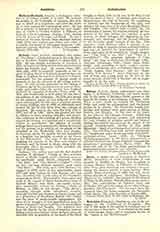

Barbour, JOHN, Scottish ecclesiastic and author of “The Bruce”, a historical poem in the early Scottish or Northern English dialect, b. about 1320; d. 1395. He was already Archdeacon of Aberdeen in 1357, an honor not likely to have been attained much before his fortieth year. At various times, 1357, 1364, 1365, 1368, he obtained, originally at the request of King David of Scotland, passports from the King of England for travel to Oxford or to France, presumably for the purpose of special study or research, or for the renewal of old college associations. In 1357 he was appointed by the Bishop of Aberdeen one of the commissioners to meet at Edinburgh and confer about the ransom from England of David II, captured at Neville’s Cross, 1346. In 1373, and occasionally in later years, he was one of the auditors of the exchequer. In 1378, as a reward for his patriotic poem, he was assigned, from the royal rents payable by the city, a perpetual pension of twenty shillings, and in 1388, an additional royal pension for life of £10 Scots from the customs of Aberdeen. He received also from the king £10 in 1377, and £5 in 1386. Innes has pointed out that in addition to these pensions and gifts, and perquisites incidental to the wardship of a minor, Barbour enjoyed the revenue of a prebend and a considerable income as archdeacon. His pension of twenty shillings he left as a foundation for Masses for himself and his parents, to be said by all the priests at the cathedral on the Wednesday after Low Sunday. As Jamieson shows, the pension was not bequeathed to a hospital, but probably reverted to the Crown at the Reformation. The copy of the document assigning his pension to the dean and chapter of Aberdeen may be found in Skeat, along with the forty-eight other documents which establish the facts of Barbour’s life.
Barbour, “the earliest poet and the first detailed historian of Scotland“, writing in that northern dialect of Middle English which afterward came to be specifically called Scotch, composed, besides “The Brut” and “The Stewart’s Original”, which are lost, the long patriotic narrative poem called “The Bruce”. This work, upon which Barbour was engaged in 1375, exists in two manuscripts, dated 1487 and 1489, written by John Ramsay, who has been identified with a later prior of the Carthusian monastery at Perth. The second of these copies was made at the request of Simon Lochmalony, vicar of Auchter Monsey, near Perth. An earlier, incomplete manuscript, written by Fenton, a monk of Melrose, in 1369, is not extant. “The Bruce”, extending through 6,000 octosyllabic couplets, variously divided into fourteen or twenty books, told to a generation of Scotchmen flushed with victory and the sense of dearly-bought independence the story of the struggles of their grandfathers, sang the glories of freedom, and pictured the civic and knightly virtues of Bruce and Douglas. The narrative runs from the dispute for the crown of Scotland between Balliol and the first Robert, whom Barbour poetically identifies with his grandson, to the death of the Black
Douglas in Spain while on his way to the Holy Land with the heart of Bruce. It pictures such events as Bannockburn, the siege of Berwick, the expedition to Ireland, and the wanderings of the king, and sketches the characters of Stewart, Randolph, Bruce, and Douglas. The author finds a place, too, for descriptions of nature, for touches showing the tenderness of the true soldier, for snatches of grim humor or sharp dialogue, for digressions on necromancy and astrology, and for learned allusions to the favorite classic authors of the day. This narrative, which Barbour called a romance, is regarded as being in essential points a faithful history, and was so received by generations of readers. Scott used some of its material in “Castle Dangerous”, “The Lord of the Isles”, and “Tales of a Grandfather”. The principal editions of “The Bruce” are those of Pinkerton (Edinburgh, 1790); Jamieson (Edinburgh, 1820); Cosmo Innes (Edinburgh), and, according to more modern requirements of scholarship, that of Professor Skeat for the “Early English Text Society“, and the “Early Scottish Text Society“. Some fragments on the tale of Troy, and a long poem on the lives of the saints formerly attributed to Barbour are no longer thought to be his work.
J. VINCENT CROWNE

